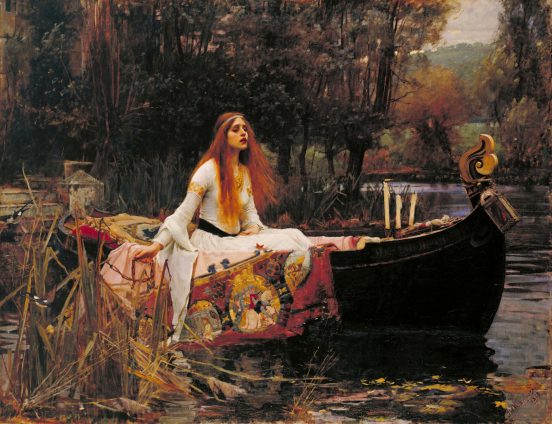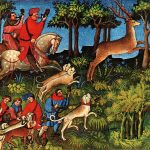Mackenzie Lott
ENGL 221
Professor Marlene Briggs
22 November 2017
Major Essay: The Poetry of the Victorian Age
Men and women in industrial England led separate lives—men owned “the world of action and aggression” while “women were to preside over the domestic sphere” (Henderson 1520). Writers like Christina Rossetti and Alfred Lord Tennyson began to question separate gender roles and wrote about the potential effects of such ideals on the individual. In their poems “Lady of Shalott” (published in 1833) and “Goblin Market” (published in 1862) these poets present their perspectives through Laura and the Lady, two maidens who have been restrained from life’s joys. There are viable claims that their stories are cautionary tales or narratives of sexuality, but here I will forgo these in favour of another: That by trapping their women with societal pressures and then coaxing them out with stereotypical Victorian males Rossetti and Tennyson give their protagonists a felix culpa which paradoxically releases them from their bonds and endows them with a sense of purpose hitherto unknown. In each case, these narratives function on multiple levels to advocate for women’s unrestrained pleasure and freedom.
Rossetti and Tennyson introduce their protagonists by associating them with the lily flower and then hem them in with warnings to create symbolic dilemmas. As people walk by the home of Tennyson’s Lady of Shalott they gaze “where the lilies blow / Round the island there below” (7-8). Lilies, delicate flowers commonly associated with frailty and femininity, are a recurring image in the poem and even begin to mirror the Lady of Shalott as the narrative progresses. This image of purity contrasts the curse which will fall upon her “If she stay / To look down to Camelot” (Tennyson 40-41). Though the curse is in some ways ambiguous it can be understood as an imposition on the Lady’s freedom, one which represents the many societal restrictions placed on women at the time. Rossetti also introduces the image of the lily early on in “Goblin Market” as she uses a simile to compare Laura’s face and neck to “a lily from the beck” (83) and again later when she describes Lizzie as being “Like a lily in a flood” (409). By associating the sisters with this image Rossetti likewise surrounds them with Victorian Era expectations. Unlike the lady of Shalott Laura is not explicitly cursed but she is confined by the “wise upbraidings” (Rossetti 142) of her sister, who echoes the Victorian cliché that “Twilight is not good for maidens” (Rossetti 144) and reminds her of Jeanie, a girl whose palate for adventure became the death of her (Rossetti 147-161). Lizzie restrains Laura from experiencing the life she wishes to live and in this sense her problem mirrors that of Tennyson’s lady. By repeatedly symbolizing the image of the lily and imposing confinements on their characters Tennyson and Rossetti set up their narratives to exemplify the social pressures often placed on Victorian Era women.
These poets then use men who embody freedom and associate them with the colour red to tempt each woman out of her symbolic role. Part two of Tennyson’s poem concludes with a discontented Lady of Shalott and part three begins with Lancelot galloping past her tower; as he rides his helmet and helmet feather burn “like one burning flame together” (94) and he vacantly sings “‘Tirra lirra’” (107) within her earshot. Tennyson uses the colour red to spur the Lady’s desire and invokes the care-free Shakespearean refrain to demonstrate how the lives of Victorian men were both a temptation and a mockery to their female counterparts. When she hears his singing the Lady of Shalott cannot help herself—she sees the water lily bloom, she sees the helmet and the plume—and turns from chaste to cursed in an instant. In her effort to glimpse the joy that nature can bring the Lady of Shalott discovers her fate. Rossetti’s Laura similarly seeks out violent goblin men, sees their “globes fair or red” (128), hears their refrain of “Come buy, come buy” (104) and in spite of all her sister’s warnings tastes the juice of the forbidden fruit. In either case Rossetti and Tennyson tempt and taunt their women with singing men and the colour red, causing them both to take the fatal step beyond their sphere. By luring these maidens in this way these poets depict Victorian women’s love-hate relationship with men and catalyze the kinds of downfalls that Victorian women often succumbed to.
Laura and the Lady suffer for their breaches of social code but a closer reading of their fall reveals that their actions are justified through the personal rewards they experience. The reader first finds the Lady of Shalott floating down the river singing “a song that echoes cheerly” (Tennyson 30). This would indicate that she derives joy in her descent from the tower. Having seen the reflection of so many knights and lamented how “she hath no loyal knight and true” (Tennyson 62) it is likely that she would get satisfaction from having a night for herself. Granted it is a night of a different sort, but by using this homonym Tennyson allows a maiden to experience life’s darker side and thereby turns his narrative into a subtle exploration of transcended female boundaries. “Goblin Market” does something similar when Laura indulges herself and then falls ill. The brief ecstasy of the fruit seems overshadowed by her withdrawal from it, but an understanding of Rossetti’s life and of Victorian life in general shows that Laura’s situation may be more complex than it appears. Henderson and Sharpe say that in the Victorian Era an “illness could liberate a lady” (1521) and that Rossetti herself “suffered mysterious maladies that served to protect her time and talent” (1643). Laura suffers, but her sickness also forces Lizzie and her wise words to take over her share of the housework and give Laura some space. By granting their women’s wishes through hidden levels of depth Rossetti and Tennyson each manage to appeal to the Victorian public while also introducing the notion of female freedom.
These poets go further still, endowing their protagonists with a sense of purpose and a first-hand knowledge of life’s real dangers. When Laura finds out that Lizzie has staked her life for her own an odd change occurs: The fruit juice which once tasted “Sweeter than honey” (Rossetti 129) becomes “wormwood to her tongue” (Rossetti 494) and Rossetti likens her to “a caged thing freed” (505). Initial reading suggests that the second taste of fruit cures Laura but under closer scrutiny this idea falls short and leaves the reader wondering whether the fruit holds any power at all. Rossetti’s Laura assumes that the “‘Thirsty, cankered, goblin-ridden’” (484) Lizzie has also tasted the juice and the juxtaposed comparisons of its flavour suggest that Laura’s imagination has caused her illness and that it is her sister’s devotion which brings her back to life. This exposes another potential parallel to “The Lady of Shalott”, namely, the fallacy of the curse. At the poem’s outset “little breezes dusk and shiver” (Tennyson 11) and there are “reapers, reaping early” (Tennyson 28). These descriptions indicate early autumn and the reaper adds a further intimation of death, making it feasible that the Lady of Shalott has died from exposure to the elements and not from a curse. In disclosing the fallacy of magic in these ways each poet dissolves the mistaken beliefs which surround their women. The Lady’s death also carries meaning, for her boat and body find their way to Camelot and its residents. In coming ashore she stops being “the fairy / Lady of Shalott” (Tennyson 35-36) and her life turns from folklore into public knowledge. The laypeople are still afraid but Lancelot calms them when he consecrates her death, saying “‘She has a lovely face; / God in his mercy lend her grace / The Lady of Shalott’” Tennyson 169-171). By dispelling the illusions that surround her and making her name known Tennyson gives his Lady a legacy. Just as her story lives on, Laura and Lizzie are able to tell their children together how “‘there is no friend like a sister / In calm or stormy weather’” (Rossetti 562-563). In solidifying their women as people with wisdom and meaning Tennyson and Rossetti turn their women into exemplars of female strength in the Victorian Era.
Other readings of these poems highlight themes of sexuality or even advocacy for separate spheres and formal aspects of “The Lady of Shalott” and “Goblin Market” corroborate such claims. I have chosen my reading over these other interpretations for the wealth of evidence available and because I believe the message of female freedom surpasses them in importance, but for the sake of argument I will examine each presentation and weigh it against my own. Let us begin with sexuality in Tennyson’s ballad: True to form, the poet immerses us in a medieval England where surreality abounds. We are given a knight in shining armour and a lonely Lady confined to her tower who sees “two young lovers lately wed” (Tennyson 70) and expresses her dissatisfaction, saying “I am half sick of shadows” (Tennyson 71). When Lancelot rides past her window she sees “the water-lily bloom” (Tennyson 111), a floral image which conveys ideas of female sexual maturity and ovulation. Yet even Lancelot appears as “Some bearded meteor, trailing light” (Tennyson 98) and when she sees the young lovers it is their shadows and not their love that she censures. While the lily may represent her sexual maturation she either keeps it unblemished or gives it over to the darkness; either way, this interpretation stops here. Notions of sexuality abound in “Goblin Market” as well. Laura has met with animalistic men and “sucked their fruit globes fair” (Rossetti 128) and when Lizzie returns to help her she cries “‘Eat me, drink me, love me / Laura make much of me’” (Rossetti 471-472). These lines read as sexual euphemisms and it makes sense that sexual freedom would play a role in this poem. Still, the concluding reflection on sisterhood as friendship unifies more explicitly with the theme of female liberation. Finally we have the reading that upholds separate spheres. It might seem unlikely that “a shy and sensitive man” (Henderson 1175) or a woman of “strict Anglo-Catholic principles” (Henderson 1643) would write poetry with subversive themes, yet they were commonplace in the era. In the anthology containing these poems Henderson and Sharpe say of 19th century writing that “Magical events permitted writers and readers to enter forbidden realms of violence, temptation, and transformation,” and that “moralized endings sought to tame even the wildest tales for social and ethical instruction” (Henderson 1644). In this light the surreality of these poems makes perfect sense, and I personally cannot think of any two works that embody these accompanying ideas more fully.
Laura and the Lady of Shalott begin their respective narratives as women who are boxed in by external pressures. As their stories progress they become suffocated by their circumstances and allow themselves to be tempted by men who are their societal opposites. Whether knowingly or not these men mock them to the point of madness until they are forced into defying their impositions in pursuit of their basic human desires. Their actions first appear as iniquities but subtleties in these poems reveal that their choices are actions of courage which allow them to bridge the societal gap and cross into lives of deep happiness and meaning. Through these two poems Alfred Lord Tennyson and Christina Rossetti subversively espouse freedom and transcendence for women with a skill that has given “The Lady of Shalott” and “Goblin Market” lasting significance in the discourse on gender equality and in the history of British literature.
Works Cited
Henderson, Heather, and William Sharpe, editors. The Longman Anthology of British Literature. Vol. 2B, Pearson Education Inc., 2010.
Rossetti, Christina. “Goblin Market”. The Longman Anthology of British Literature. Edited by Heather Henderson and William Sharpe, Vol. 2B, Pearson Education Inc., 2010, pp. 1181-85.
Tennyson, Alfred. “The Lady of Shalott”. The Longman Anthology of British Literature. Edited by Heather Henderson and William Sharpe, Vol. 2B, Pearson Education Inc., 2010, pp. 1650-63.






Robert reipt
December 27, 2018 — 10:17 am
An Arthurian legend inspired one of Tennyson’s most famous poems. You consider how ‘The Lady of Shalott’ reflects contemporary questions of gender and creativity, and provides the subject for works by artists including Dante Gabriel Rossetti and William Holman Hunt.
temple run 2
January 3, 2020 — 4:50 am
Laura and the Lady of Shalott begin their respective narratives as women who are boxed in by external pressures. As their stories progress they become suffocated by their circumstances and allow themselves to be tempted by men who are their societal opposites. Whether knowingly or not these men mock them to the point of madness until they are forced into defying their impositions in pursuit of their basic human desires. Their actions first appear as iniquities but subtleties in these poems reveal that their choices are actions of courage which allow them to bridge the societal gap and cross into lives of deep happiness and meaning. Through these two poems Alfred Lord Tennyson and Christina Rossetti subversively espouse freedom and transcendence for women with a skill that has given “The Lady of Shalott” and “Goblin Market” lasting significance in the discourse on gender equality and in the history of British literature.
nagar
December 18, 2021 — 5:43 am
Hello users we here and now look it here the a new version game bejeweled 3 i am sure you can easy to play this game.
five nights at freddy's
August 4, 2022 — 12:14 am
The information you have posted is very useful.
dordle
August 18, 2022 — 9:08 pm
Dante Gabriel Rossetti, William Holman Hunt, and others have used “The Lady of Shalott” as inspiration for their own artistic explorations of gender and originality in the modern day.
iscribble
December 6, 2022 — 2:33 am
Laura and the Lady of Shalott begin their respective narratives as women who are boxed in by external pressures. As their stories progress they become suffocated by their circumstances and allow themselves to be tempted by men who are their societal opposites.
Maria
February 1, 2023 — 6:11 am
It’s amazing!
(https://google.com/)
cut mover
February 27, 2023 — 6:54 pm
Thank you very much, I have been seeking for this information for a very long time, and the information that you provided in your article has been very helpful to me in my work.
mentalabrupt
March 2, 2023 — 1:55 am
Dante Gabriel Rossetti, William Holman Hunt, and others have utilized “The Lady of Shalott” as inspiration for their own creative explorations of coreball gender and individuality in the current day.
lily coliins
April 20, 2023 — 8:06 pm
Thank you for sharing your expertise incredibox and passion with the world through your article. It’s clear that you care deeply about the topic and it really comes through in your writing.
Coreball
May 12, 2023 — 1:01 am
This article is good. Thank you so much for the best regards.
Markopolo
July 5, 2023 — 12:06 pm
An interesting approach to writing, here it is worth noting that it is also a picture of incredible beauty. Similar ones can be found here san antonio texas images These are pictures that can be used to describe nature and get a good grade in college
Marko Merpovich
July 15, 2023 — 11:11 am
An instructive story, I liked it. This can be used to write an essay, but with help capstone project help This will help me a lot to be more successful in college and improve my writing skills
Markopolo
July 20, 2023 — 10:32 pm
They claim reading a lot helps people become better writers. This is a really fantastic instructional narrative. A competent educational platform https://edureviewer.com/sites-like-educative/ however, will hasten this procedure. In order to assure the accuracy of training and set specific procedures to foster better work as a publicist or writer, it is crucial to choose the suitable educational platform for beginning.
hill
August 13, 2023 — 7:46 pm
Hope the blog grows and brings more good articles. Wish the blog more and more success and continue to inspire the community. Go to -> Drift Hunters try and see how it is.
online
October 3, 2023 — 12:35 am
A very useful essay! There is a ton of information about the run 3 in this article that can assist anyone in beginning a productive social media campaign.
salmawisoky
October 5, 2023 — 4:28 am
Drift Boss offers a challenging yet rewarding gameplay experience, allowing players to compete against themselves or challenge friends to beat their high score. With its addictive gameplay and intuitive controls, this game is sure to keep players entertained for hours as they strive to become the ultimate drift
randolphshaw
November 30, 2023 — 2:15 am
Other interpretations of these poems emphasize eroticism or perhaps advocacy. geometry dash scratch
Nicky
December 1, 2023 — 7:54 pm
The article provides a comprehensive overview without overwhelming the subway surfers reader.
Richard Liam
December 27, 2023 — 5:55 am
“The Lady of Shalott” enthralls with its eerie story, elucidating similarities between the limitations imposed by society norms and those faced by the enigmatic lady. Tennyson’s poem brings to mind the subtle interplay between freedom and confinement, as well as the difficulties involved in making one’s own decisions. It’s interesting how, as I read through this literary masterpiece, I can’t help but make parallels between it and my current search for interesting economics dissertation ideas—two domains that are richly layered and just waiting to be untangled.
Liam Smith
January 23, 2024 — 8:57 pm
Consider incorporating transitions to guide the reader through driving directions in your analysis smoothly.
Andy Votty
February 12, 2024 — 10:35 am
Exploring the comparative essay on Rossetti and Tennyson on blogs is truly enlightening! Amidst the insightful analysis and literary exploration, it’s essential to acknowledge the invaluable support of dnp capstone project writers. With their expertise and guidance, crafting compelling essays becomes a seamless journey. Trust me, with dnp writing services by your side, academic success is not just attainable, but inevitable!
james willim
February 28, 2024 — 11:48 pm
Our PECB ISO-9001-Lead-Auditor practice test is the most reliable solution to quickly prepare for your PECB Designing PECB Azure Infrastructure Solutions. We are certain that our PECB ISO-9001-Lead-Auditor practice exam will guide you to get certified on the first try. Here is how we serve you to prepare successfully.
ISO-9001-Lead-Auditor course fees
dallasflynn
March 19, 2024 — 2:35 am
I’d like people to know how good the information in your text is. The shell shockers online is interesting
Jenna
March 30, 2024 — 4:24 am
Truly enlightening! It’s fascinating how both poets utilize symbolism and narrative structure to depict the societal constraints faced by Victorian women and their eventual defiance against them. Your exploration of the protagonists’ journeys from confinement to liberation sheds light on the complexities of gender roles during that era.
splatt
April 7, 2024 — 10:47 pm
Your insightful analysis truly enhances the discourse on Goblin Market. The depth of your understanding shines through in each comment, making it a valuable addition to the conversation. As someone currently exploring options for Data collection services for phd, I appreciate the diverse perspectives shared here.
Aljon Fe
April 11, 2024 — 11:19 pm
Wow!!! I love this essay so much 🙂 Victoria, BC Residential Roofing
Thomas
April 17, 2024 — 11:43 am
Crossway Consulting is a Full-Service Digital Agency that empowers businesses to thrive in the dynamic digital landscape. We dedicate our expert team to deliver innovative and impactful solutions, ensuring your business achieves its goals with a robust digital presence.
Search Engine Optimization (SEO)
Social Media Management (SMM)
Website Design & Development
Mobile App Development
Software Development